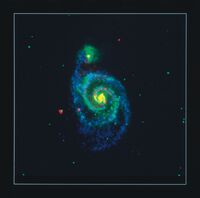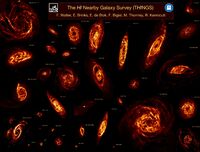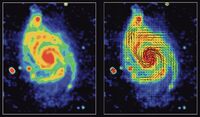Legacy Astronomical Images > Galaxies Series > Spiral Galaxies Unit
Description
Spiral galaxies consist of a flattened rotating disk of young stars, a central bulge of generally older stars, and a surrounding halo of older stars and dense clusters of old stars called globular clusters. The disk is prominent due to the presence of young, hot stars often arranged in a spiral pattern. Spiral galaxies are sometimes the hosts of energetic nuclei which emit jets of high-energy particles which are visible in the radio. Images of those objects are categorized separately under the heading Active Galactic Nuclei, most often in the Seyferts sub-catagory.
Collection Items
Collection Tree
- Legacy Astronomical Images
- Legacy Astronomical Images > Galaxies Series
- Legacy Astronomical Images > Galaxies Series > Spiral Galaxies Unit
- Legacy Astronomical Images > Galaxies Series





















